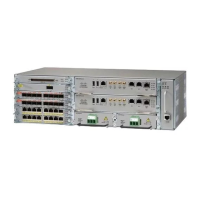Virtual Private LAN Service - VPLS
VPLS – BGP Auto-discovery and Signaling ▀
Cisco ASR 903 Router Design and Deployment Guide▄
Neighbors connected via pseudowires:
Peer Address VC ID Discovered Router ID S
10.10.2.2 35 10.10.2.2 Y
10.10.3.3 35 10.10.3.3 Y
PE-1# show mpls l2transport vc 35
Local intf Local circuit Dest address VC ID Status
------------------ ------------------------ ----------------------- ---------- -----
-----
VFI VPLS35 vfi 10.10.2.2 35 UP
VFI VPLS35 vfi 10.10.3.3 35 UP
VPLS – BGP Auto-discovery and Signaling
The VPLS control plane is used for auto-discovery and signaling. Auto-discovery involves locating all provider
edge (PE) devices that participate in a particular VPLS instance. Signaling is accomplished by configuring pseudo-
wires for a VPLS instance. In the past, LDP was used for signaling and BGP was used for auto-discovery (RFC
6074). Now, the VPLS BGP Signaling L2VPN feature supports RFC 4761 by simplifying the auto-discovery and
signaling of all known PE devices in a VPLS instance by using BGP for both functions.
PE-1 configuration
l2vpn vfi context VPLS30
vpn id 30
autodiscovery bgp signaling bgp
ve id 32 ! VE ID must unique in the same VPLS domain
bridge-domain 30
member GigabitEthernet0/0/4 service-instance 2
member vfi VPLS30
router bgp 100
neighbor 10.10.2.2 remote-as 100
neighbor 10.10.2.2 update-source Loopback10
neighbor 10.10.3.3 remote-as 100
neighbor 10.10.3.3 update-source Loopback10
address-family l2vpn vpls
neighbor 10.10.2.2 activate
neighbor 10.10.2.2 send-community extended
neighbor 10.10.2.2 suppress-signaling-protocol ldp ! suppress LDP to use
BGP
neighbor 10.10.3.3 activate
neighbor 10.10.3.3 send-community extended
neighbor 10.10.3.3 suppress-signaling-protocol ldp

